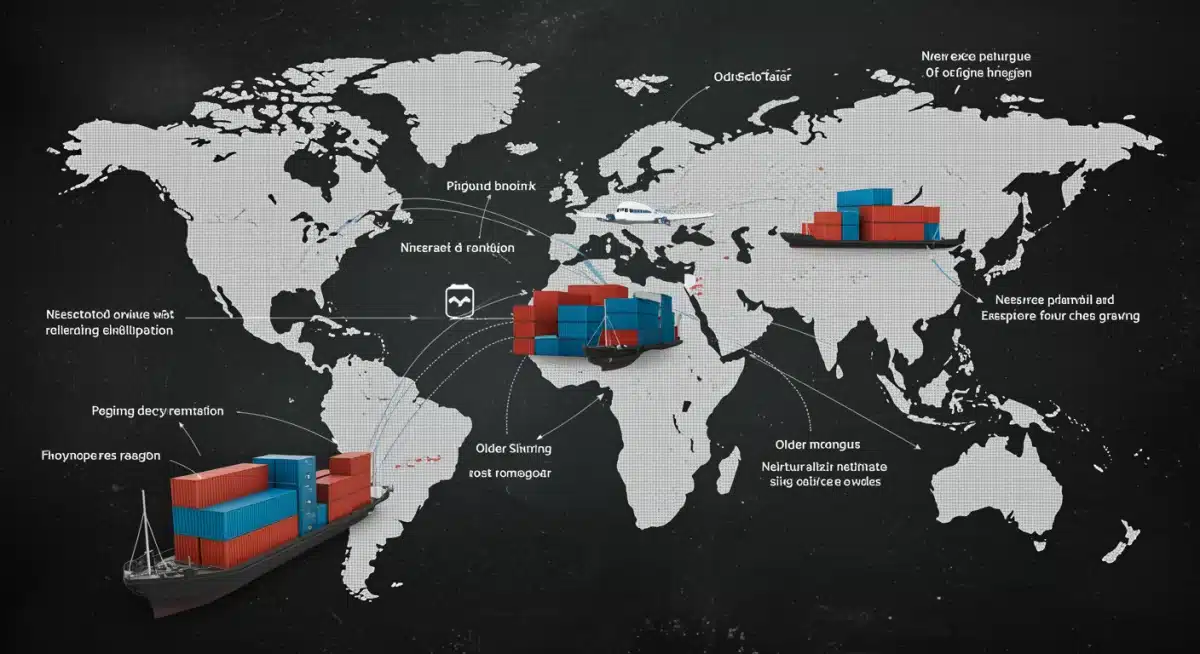Geopolitical Tensions Reshaping US Trade: A 12-Month Outlook

A Special Report: How Geopolitical Tensions Will Reshape US Trade Relations in the Next 12 Months reveals a rapidly evolving landscape. Recent developments underscore a profound shift in global economic alliances and supply chain strategies, impacting businesses and consumers alike.
Escalating Tensions Drive Trade Policy Shifts
The past year has seen a significant uptick in geopolitical friction, directly influencing US trade policy. Nations are increasingly leveraging economic tools to assert influence, leading to a complex web of tariffs, sanctions, and strategic partnerships. This environment necessitates a proactive approach from US policymakers and businesses.
The China-US Dynamic
The ongoing trade and technological rivalry between the United States and China remains a central driver of these shifts. Recent actions, including expanded export controls on advanced semiconductors and investments in domestic manufacturing, highlight a clear strategy to reduce reliance on Chinese supply chains. These measures aim to safeguard national security interests and foster technological independence.
- Export Controls: Restrictions on critical technologies to prevent military applications.
- Tariff Reviews: Ongoing discussions about the efficacy and future of existing tariffs.
- Investment Screening: Increased scrutiny of foreign investments in sensitive sectors.
These policy adjustments are not merely reactive; they represent a fundamental re-evaluation of long-term economic engagement. The focus is shifting towards resilience and strategic autonomy, a trend expected to intensify over the coming year.
Supply Chain Diversification and Reshoring Initiatives
The vulnerabilities exposed during recent global crises, coupled with geopolitical instability, are accelerating efforts to diversify and reshore critical supply chains. The US government is actively promoting incentives for domestic production, particularly in key sectors such as semiconductors, pharmaceuticals, and renewable energy components.
Companies are now re-evaluating their global footprint, moving away from single-source dependencies. This strategic pivot aims to mitigate risks associated with geopolitical shocks, natural disasters, and trade disputes.
The CHIPS and Science Act Impact
The CHIPS and Science Act, enacted to bolster domestic semiconductor manufacturing and research, serves as a prime example of this reshoring push. Billions of dollars are being allocated to incentivize companies to build and expand fabrication plants within the United States. This initiative is expected to reduce reliance on East Asian production, a region increasingly viewed through a lens of geopolitical risk.
- Domestic Investment: Billions directed towards US-based semiconductor facilities.
- Job Creation: Anticipated growth in high-tech manufacturing employment.
- Technological Security: Enhanced control over critical technological inputs.
This push for domestic production extends beyond semiconductors, encompassing a broader strategy to secure essential goods and reduce economic vulnerabilities. The next 12 months will likely see further legislative and corporate actions aimed at strengthening these domestic capabilities.

Impact on Critical Raw Materials and Energy Markets
Geopolitical tensions are profoundly affecting the global markets for critical raw materials and energy. Disruptions in key producing regions, coupled with strategic competition for resources, are leading to price volatility and supply uncertainties. The US is actively seeking to secure alternative sources and develop domestic extraction and processing capabilities.
Energy security, in particular, remains a paramount concern. The ongoing conflict in Eastern Europe has underscored the fragility of global energy markets and the need for diversified energy supplies and reduced reliance on adversarial nations. This has spurred renewed interest in both traditional and renewable energy sources within the US.
Strategic Mineral Access
Access to rare earth elements and other critical minerals, essential for advanced technologies and defense, is a significant geopolitical flashpoint. The US is working to reduce its dependence on a single dominant supplier by exploring new partnerships and investing in domestic mining and refining projects. This strategy aims to ensure a stable and secure supply for vital industries.
- Resource Nationalism: Growing trend of nations asserting control over their natural resources.
- Green Energy Transition: Increased demand for minerals like lithium, cobalt, and nickel.
- Recycling Initiatives: Investment in technologies to recover critical materials from waste streams.
The coming year will likely feature intensified diplomatic efforts and significant investments aimed at securing these vital resources, reshaping trade flows and pricing mechanisms for critical commodities.
Formation of New Trade Alliances and Blocs
In response to the shifting geopolitical landscape, the United States is actively forging new trade alliances and strengthening existing ones. These partnerships are designed to create resilient economic blocs that can counter the influence of rival powers and promote shared values. Initiatives like the Indo-Pacific Economic Framework for Prosperity (IPEF) exemplify this approach.
These alliances extend beyond traditional trade agreements, often encompassing cooperation on technology standards, supply chain resilience, and environmental initiatives. The goal is to build a network of like-minded nations that can collectively address global economic challenges and maintain a stable international order.
Indo-Pacific Economic Framework (IPEF)
IPEF represents a strategic effort to deepen economic engagement with key partners in the Indo-Pacific region, focusing on four pillars: trade, supply chains, clean economy, and fair economy. This framework is a clear signal of the US’s commitment to strengthening its economic presence and influence in a critical geopolitical theater, distinct from traditional free trade agreements.
- Supply Chain Resilience: Collaborative efforts to prevent future disruptions.
- Clean Economy: Promoting sustainable practices and green technology.
- Fair Economy: Addressing issues like anti-corruption and tax transparency.
The expansion and deepening of these alliances will undoubtedly redefine global trade patterns, prioritizing trusted partners and shared strategic interests over purely economic efficiencies in the next 12 months.
Challenges to Globalization and Multilateral Trade Systems
The rise of geopolitical tensions poses significant challenges to the traditional tenets of globalization and multilateral trade systems. The emphasis on national security and economic sovereignty is leading to a fragmentation of global markets and a potential retreat from purely free trade principles. This shift impacts international organizations like the WTO, which face increasing pressure to adapt.
Nations are increasingly prioritizing domestic interests, sometimes at the expense of broader international cooperation. This trend could lead to a more protectionist global trade environment, with increased barriers and reduced cross-border investment flows. Businesses must navigate this evolving landscape carefully, adapting their strategies to fragmented markets.
WTO’s Evolving Role
The World Trade Organization (WTO) is grappling with the implications of these geopolitical shifts. Its dispute settlement mechanism faces challenges, and consensus on new trade rules is proving difficult. The future effectiveness of the WTO in promoting open and fair trade will depend on its ability to adapt to a world where national security concerns often supersede economic liberalization.
- Dispute Resolution: Strains on the WTO’s ability to mediate trade conflicts.
- New Trade Rules: Difficulty in reaching agreements on emerging trade issues.
- Regionalism vs. Multilateralism: The growing prominence of regional trade blocs.
The next 12 months will be crucial in determining the extent to which multilateral trade systems can withstand these pressures and continue to facilitate global commerce, or if a more fragmented, bilateral approach will prevail.
Technological Decoupling and Digital Trade Wars
Geopolitical tensions are fueling a significant trend towards technological decoupling, particularly between the US and China. This involves efforts to separate technological ecosystems, driven by concerns over data security, intellectual property theft, and the weaponization of technology. The implications for digital trade, cybersecurity, and global innovation are profound.
The concept of ‘digital sovereignty’ is gaining traction, with nations seeking greater control over their data infrastructure and digital platforms. This could lead to divergent technical standards, increased regulatory hurdles for cross-border data flows, and the emergence of distinct national digital economies. Companies operating in the digital space face complex compliance challenges.
Cybersecurity as a Trade Barrier
Cybersecurity concerns are increasingly being integrated into trade policy. Nations are imposing stricter requirements on data localization and supply chain security for digital products and services. These measures, while aimed at protecting national interests, can act as significant non-tariff barriers to digital trade, fragmenting the global digital economy.
- Data Localization: Requirements for data to be stored within national borders.
- 5G Technology: Ongoing competition and security concerns surrounding network infrastructure.
- AI Governance: Efforts to establish national and international standards for artificial intelligence.
The coming year will witness intensified competition in critical technological domains, with potential for further restrictions on technology transfers and investments, fundamentally altering the landscape of digital trade and innovation.
| Key Trend | Brief Description |
|---|---|
| Policy Shifts | US trade policies increasingly driven by national security, leading to tariffs and export controls against rivals. |
| Supply Chain Reshaping | Accelerated reshoring and diversification efforts to reduce reliance on single-source suppliers. |
| New Alliances | Formation of strategic economic blocs like IPEF to counter rival influence and promote shared values. |
| Tech Decoupling | Growing separation of technological ecosystems driven by security concerns and digital sovereignty ambitions. |
Frequently Asked Questions About Geopolitical Trade Shifts
Geopolitical tensions can increase import costs through several mechanisms, including tariffs imposed on goods from specific countries, disruptions to established supply routes, and increased demand for alternative, often more expensive, sources of supply, leading to higher prices for consumers and businesses.
Reshoring is the process of bringing manufacturing and production back to a company’s home country. It’s crucial for US trade now because it reduces dependence on foreign supply chains, enhances national security for critical goods, and can create domestic jobs, mitigating risks from geopolitical instability.
Sectors heavily reliant on global supply chains and critical raw materials are most vulnerable. This includes electronics, automotive, pharmaceuticals, and renewable energy, which often depend on components or resources from politically sensitive regions, making them susceptible to disruptions.
Trade alliances like IPEF benefit US interests by creating stronger economic partnerships with like-minded nations. They facilitate cooperation on supply chain resilience, technology standards, and clean energy, reducing reliance on adversarial powers and promoting a more stable, rules-based international economic order.
While a complete reversal of globalization is unlikely, geopolitical tensions are leading to a significant re-evaluation and reshaping of global trade. The focus is shifting towards ‘friend-shoring’ and regionalization, prioritizing resilience and strategic alignment over pure cost efficiency, suggesting a more fragmented yet interconnected global economy.
What Happens Next
The next 12 months will be a critical period for US trade relations as geopolitical forces continue to exert profound influence. Businesses should anticipate increased regulatory scrutiny, further diversification of supply chains, and a continued emphasis on strategic alliances over purely economic partnerships. Monitoring evolving trade policies and adapting to a more fragmented global economy will be essential for navigating these complex shifts and maintaining competitive advantage. The interplay of national security, economic resilience, and technological leadership will define the contours of US trade for the foreseeable future.





